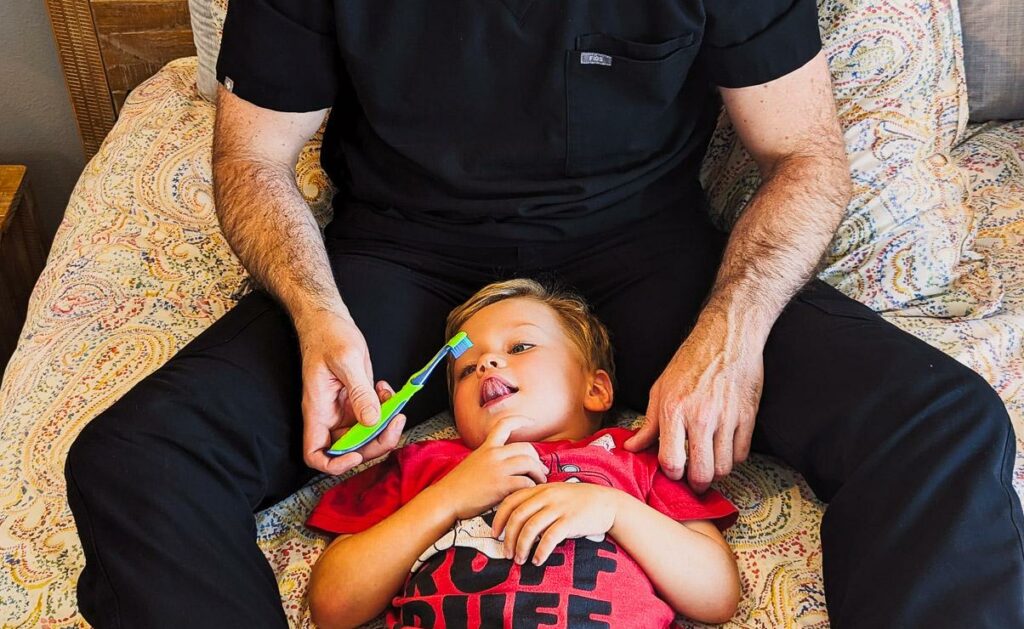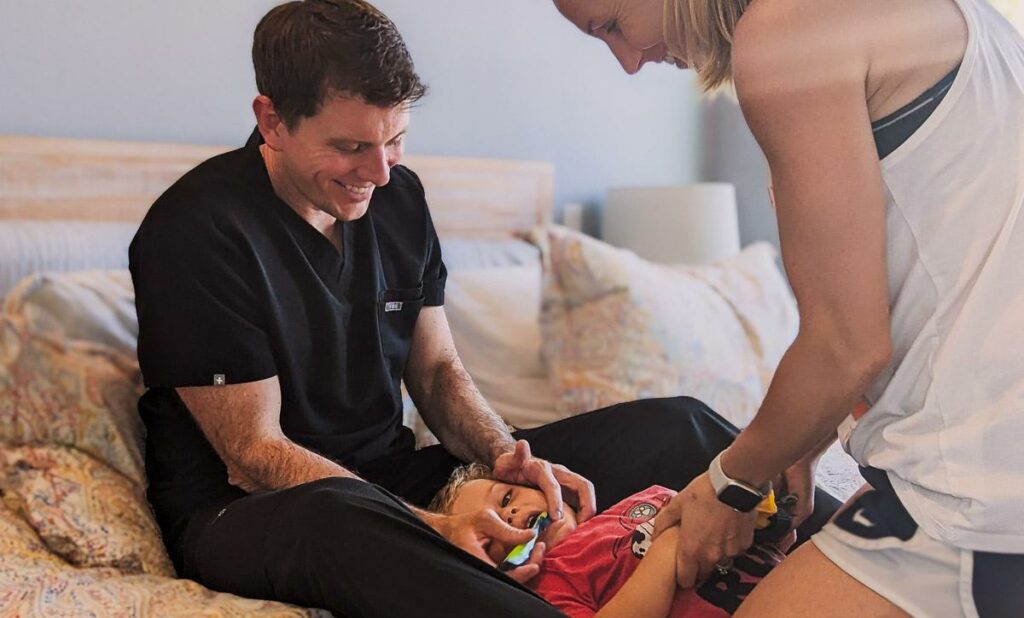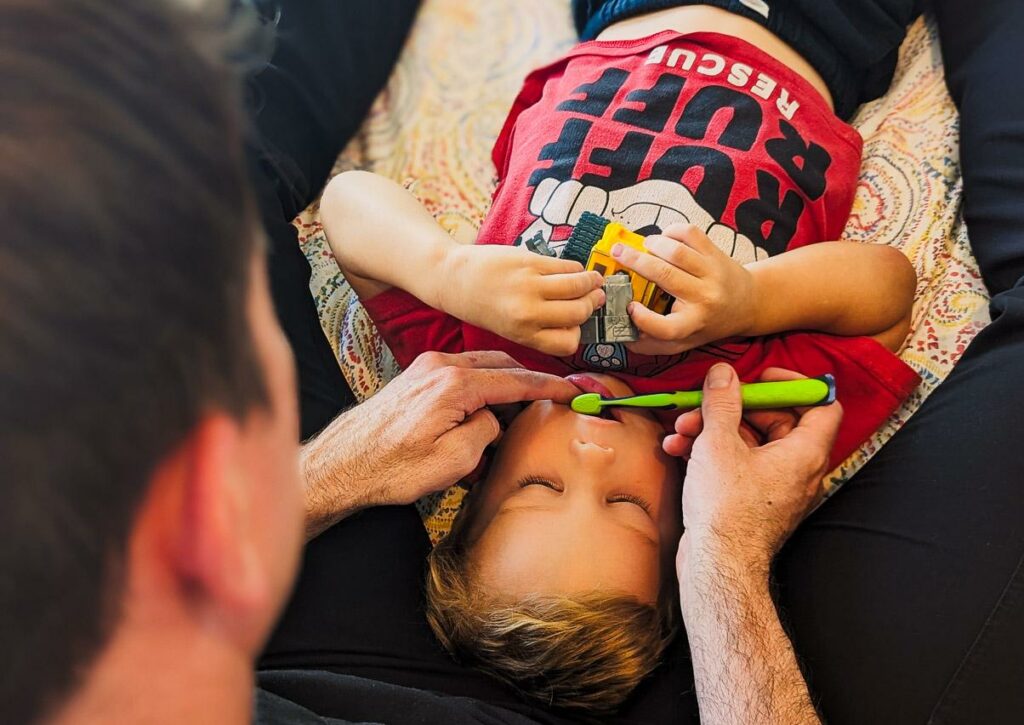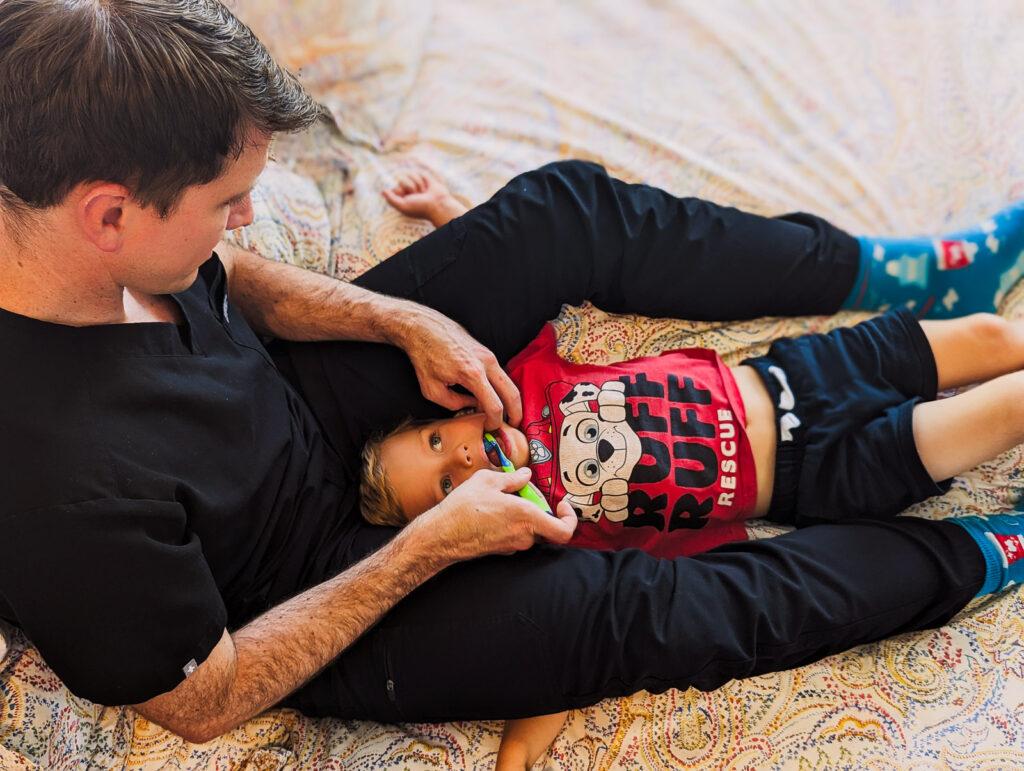As parents, we strive to provide the best for our children, ensuring their growth and well-being in every aspect of life. We’re always considering the shows they watch, the books we read, the places we visit and the experiences we curate, all to make sure our kids have the best chance to succeed in life.
I am a firm believer that the best way to give your child the absolute best oral health for the rest of their lives is to begin with your daily habits at home. I believe in the importance of healthy at-home habits so much that it’s our biggest emphasis in the coaching session we give to parents, and so we knew it also had to be the subject of our very first blog post.
I hope that as you read this, you’ll understand the importance of your involvement in your children’s home care and feel empowered to implement the method that we teach our parents at Destination Pediatric Dentistry into your daily routines. Come learn how to brush your child’s teeth, the Destination Pediatric Dentistry way.
Why we need to be involved
A question I always ask parents is: Do you think you would get cavities if your child was in charge of brushing your teeth? If the answer is “yes,” then you need to assist your child with their own brushing.
For the vast majority of young kids, you need to be more actively involved than simply reminding them to go brush on their own, or even just standing there watching. A grave mistake I often see parents make is completely passing on the responsibilities of brushing before the child is ready. I have parents that come to see us with children who can barely hold a crayon and yet are expected to brush their teeth properly on their own each night. It ain’t happening! Children often lack the dexterity and attention to detail required for effective brushing, making parental involvement essential. As children get more independent and ask to brush their own teeth, it is appropriate to give them an initial turn, but as parents, we need to step in and do our part as well. Or, as an alternative, I will have independent children take ownership of their brushing in the morning and give parents the responsibility at night (when it is most important to ensure the teeth are properly cleaned).
What is appropriate assistance?
Quite simply, it means brushing their teeth for them. Establishing a routine and guidelines for children’s oral hygiene is an extremely important step for their long term success. We coach parents to start early and be consistent and unwavering in the importance of taking care of their teeth. When children see their parents prioritizing oral health, they are more likely to internalize this lesson and develop good habits that will carry into adulthood. This simple act of parental involvement can positively impact your child’s dental health long after they’ve grown up.
How do I brush my child’s teeth?
1. LAY THEM BACK IN YOUR LAP

This is the biggest game changer I give my parents regarding brushing their children’s teeth. Get comfy on a bed with some pillows behind your back and have them lay facing up with their head in your lap (if cross legged) or between your legs with your legs straddling their head on either side. This simple act pays off in several ways:
- It will save your back. There is a reason we do dentistry sitting down with the patient laying down in front of us. My career would last approximately 6 months if I had to crouch and bend over trying to do dentistry on small children all day if they were sitting in front of me or standing up. Ergonomically it’s an absolute nightmare for you as the parent if you are brushing their teeth with them sitting in front of you or standing up.
- You can do a better job. With their mouth right in front of your eyes, you have a much better ability to position the toothbrush to reach their back teeth and rotate it around to properly brush all sides of their teeth. Visibility is much better as well, so you can see areas you might have previously missed.
- You have much better control. A child who is laying down can really only move their head from side to side if they are not interested in having you brush their teeth. If you are patient and firm in the need to brush, you still have the ability to safely clean their teeth in those instances. A child who is standing or sitting in front of you can move away much more easily, and not only does that make your job of brushing harder, but it’s also less safe for them.
- It prepares them for their visits to the dentist. For the reasons listed above, it is absolutely necessary for our patients to lay back when they go to the dentist. If they are not used to doing it at home, the simple act of laying back can be a vulnerable position for infants and toddlers, and it can be a real struggle (mostly for the parents) to have them crying and struggling when we lay them back for their cleaning and exam. If you are doing this nightly at home already, it makes everyone’s life much easier when you come visit us.
2. CONTROL THEIR HANDS
What happens with an infant or toddler when you’re trying feed them a food they aren’t interested in? In my experience, their lips are closed and their little hand shoots up and grabs the spoon, often sending that food flying onto the floor. You’ll get the same reaction to the toothbrush from infants and toddlers who don’t want their teeth brushed. Hands shoot up and grab your hands or toothbrush to stop you from doing what you need to do. It is NORMAL for infants and toddlers to have this reaction. Controlling their hands in this instance isn’t cruel or traumatizing. Would you let them grab a knife or flame? Controlling their hands during brushing is a necessary step for you to properly brush their teeth. So how do you do it?
Use a helper

A second person to assist in brushing can be holding the child’s hands on their belly and also serve as a distraction while you brush. They can sing to your child, read them a book, or simply offer a calm and reassuring face that they trust to let them know that everything is ok.
Give them something to do with their hands

Sometimes for older toddlers, giving them a stuffed animal or something else that they can focus on with their hands can distract them from grabbing at the toothbrush.
Use a towel to swaddle

One of my favorite tricks to free up my hands is to brush teeth right after the bath-time routine. Using the towel, you can wrap their arms at their sides with the ends tucked under their body as you lay them on the bed to brush their teeth.
Use your legs to keep their arms safely to the side

When you lay them down, calmly and safely pull their arms out to the side and tuck their forearms and hands under your thighs.
3. USE BOTH OF YOUR HANDS
As the person brushing the teeth, you can use your non-dominant hand to retract the cheek and lip so you can properly brush along the gumline. If your child tenses up and is unwilling to participate, you can use your extra hand and fingers to (GENTLY!!!) retract the cheek or lips so that you can do what you need to do.
4. BRUSH FOR THE RIGHT AMOUNT OF TIME
Using just a small bit of fluoride toothpaste, the size of a grain of rice, brush all of their teeth on all sides for the next minute (if they only have anterior teeth) to two minutes. Be sure to thoroughly brush the back molars, as these are often the teeth on which kids get their first cavity. Bonus points if you can brush their tongue too!
5. SIT THEM UP TO PRAISE OR REASSURE THEM
If it’s been a real struggle during that brushing session, give them reassurance and hugs. If they were cooperative, let them know they did great and that you appreciate their help. It’s very normal for kids to not love brushing their teeth, especially in the beginning. You may have easy days and you may have hard days, but the important thing is that you are consistent and a leader in emphasizing its necessity. It may be an absolute struggle at first, but stick with your consistent routine and it will get easier over time.
6. AVOID ANY FOODS OR BEVERAGES (other than water) AFTER BRUSHING.
Giving them milk, juice or any other snacks will completely negate what you just did. I prefer to have kids go to bed without rinsing to keep the topical fluoride on their teeth while they sleep. If you use the appropriate small smear of toothpaste, there should be no concern with them consuming too much.
Wrap-up:
Parental involvement in children’s oral hygiene is not merely a responsibility; it is an opportunity to foster a lifetime of good oral health habits, strengthen bonds, and promote overall well-being. By actively engaging in their child’s brushing routine, parents lay the groundwork for a sparkling smile that will last a lifetime. Consistency, routine and boundaries are an important framework for setting up your child for dental success in the long term, and it all begins with us as parents.
Do you want better guidance on how to take care of your child’s teeth? Contact us to make an appointment!
